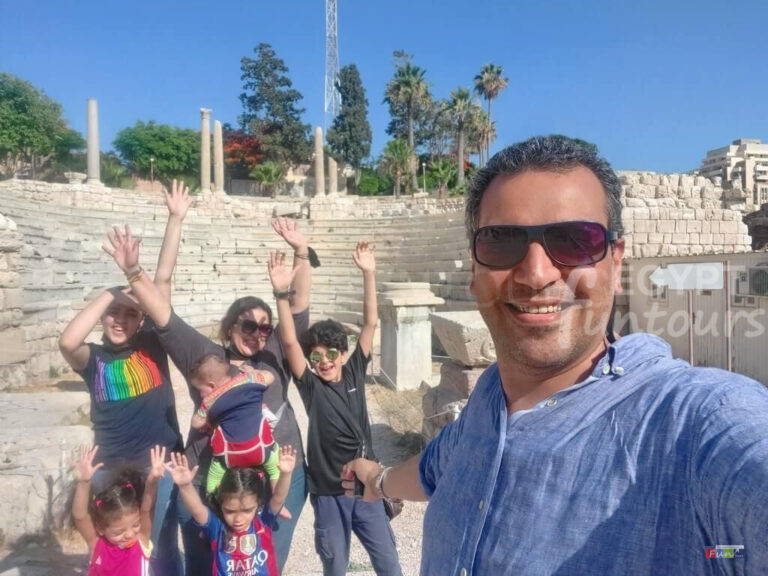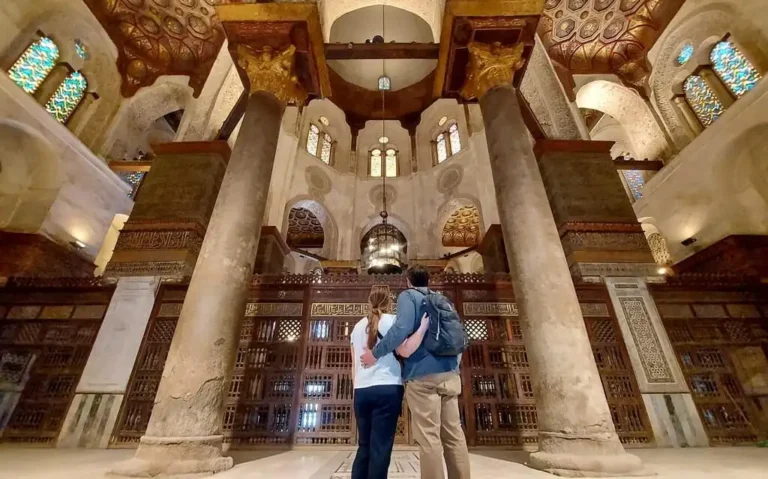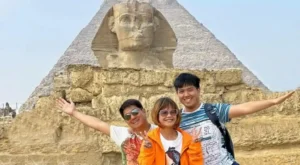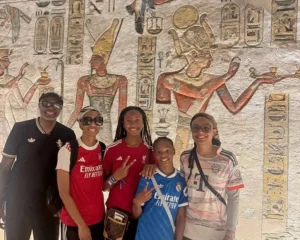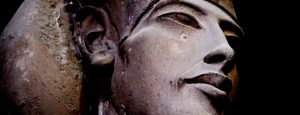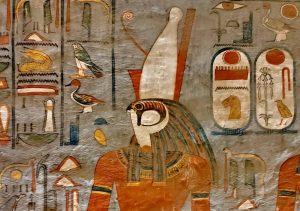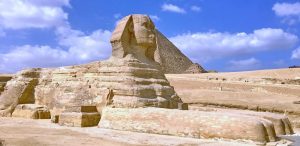The Profound Egyptian Influence on Greek Civilization
Ancient Greece is often called the cradle of Western civilization. But its brilliance didn’t emerge in a vacuum. It was built upon the knowledge and wisdom of older cultures. Among these, ancient Egypt stands as a towering source of inspiration. The cultural exchange between these two great civilizations was not a one-way street. It profoundly shaped early Greek civilization, influencing everything from their art and architecture to their religion and philosophy. Explore the deep Egyptian influence on Greek civilization.
Foundations of the Egyptian Influence on Greek Civilization
The relationship between Greece and Egypt began long before the classical period. Mycenaean Greeks traded extensively with Egypt, bringing back papyrus, linen, and other valuable goods. By the Archaic period (c. 800–500 BCE), Greek merchants established a major trading post called Naucratis in the Nile Delta. This city became a vital hub. It allowed for direct and continuous contact between Greeks and Egyptians. Through this commerce, ideas, technologies, and artistic styles flowed freely. The cultural exchange between Egypt and Greece was foundational.
Greek and Egyptian Mythological Parallels
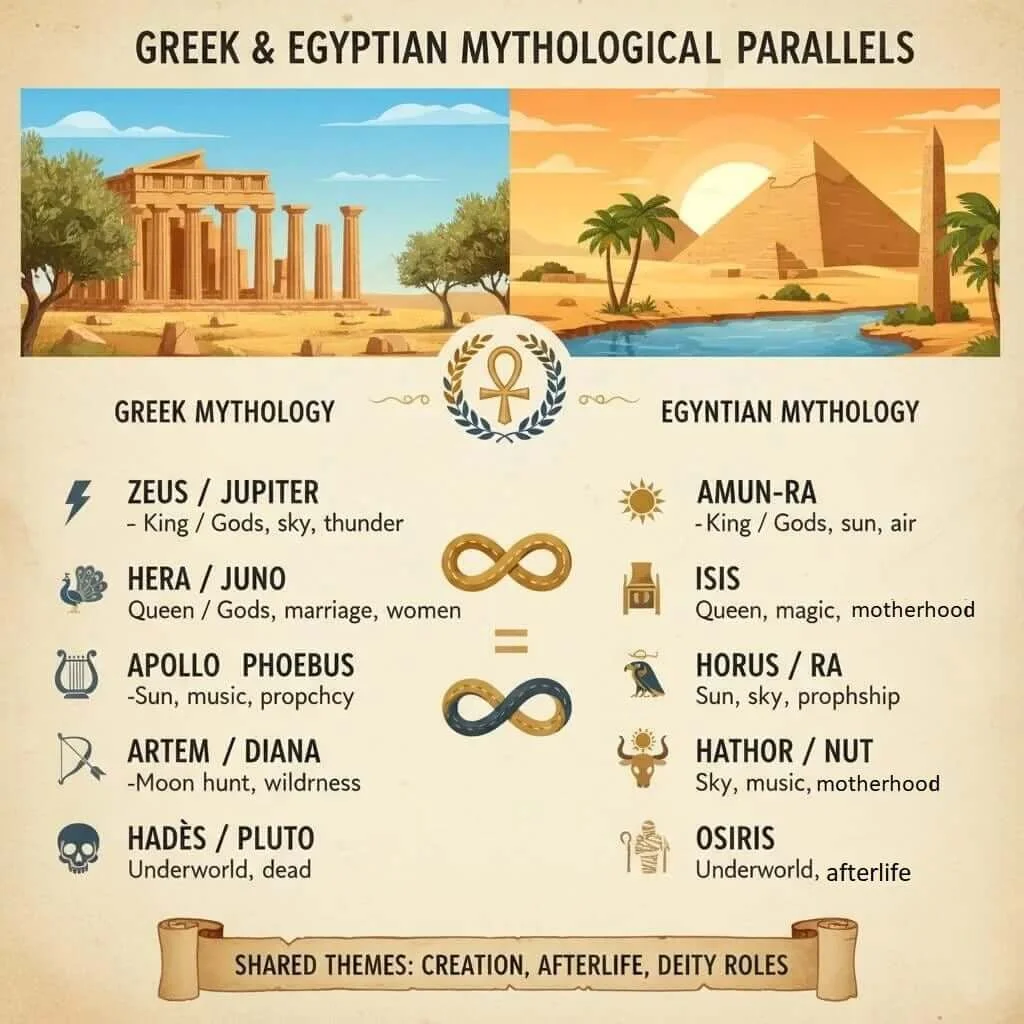
The Striking Parallels in Greek and Egyptian Creation Myths
The creation myths of ancient Greece and Egypt, despite being separated by geography, share striking parallels that reveal a common human desire to explain the origins of the world. The Egyptian influence on Greek civilization is evident in these shared themes. Both cultures began their cosmogonies with a state of primordial, undifferentiated chaos.
In Greek myth, this was Chaos, a dark and formless void, while the Egyptians envisioned a chaotic, watery abyss called Nun. From these initial states of disorder, a self-created deity emerged to bring order. In Egypt, the sun god Ra rose from the waters of Nun, while in Greek tradition, a powerful earth goddess like Gaia often emerged from Chaos to begin the process of creation.
Both mythologies also established a divine family to organize the cosmos. The Greek pantheon of Olympians and the Egyptian Ennead (a group of nine deities) both featured a creator god and his descendants who governed the elements of the world. These shared themes of order from chaos and the establishment of a divine hierarchy highlight how ancient cultures, though distinct, arrived at similar conclusions about the fundamental mysteries of existence.
Beyond the Harvest: How the Cults of Isis and Demeter Overlap
The cults of the Greek goddess Demeter and the Egyptian goddess Isis share striking parallels that go “beyond the harvest” and delve into themes of grief, resurrection, and the promise of a blessed afterlife. Both cults centered on a mother figure’s journey to find a lost loved one. Demeter, the goddess of the harvest, mourned the abduction of her daughter Persephone by Hades. Her grief led to the barrenness of the earth. Similarly, Isis, a mother and powerful sorceress, grieved for her murdered husband Osiris, whose body was scattered across Egypt.
These mythological narratives became the basis for exclusive mystery cults that promised initiates a blessed existence after death. The Eleusinian Mysteries of Demeter offered initiates hope for a happier afterlife through a series of secret rites related to Persephone’s return. In a similar vein, the cult of Isis, which became immensely popular throughout the Hellenistic and Roman worlds, offered its followers the promise of eternal life, mirroring the successful resurrection of her husband Osiris. These shared spiritual promises and mythological themes reveal a deep, cross-cultural resonance, showing how both civilizations sought to find meaning and hope in the face of death.
How Egyptian Motifs Shaped Early Greek Art
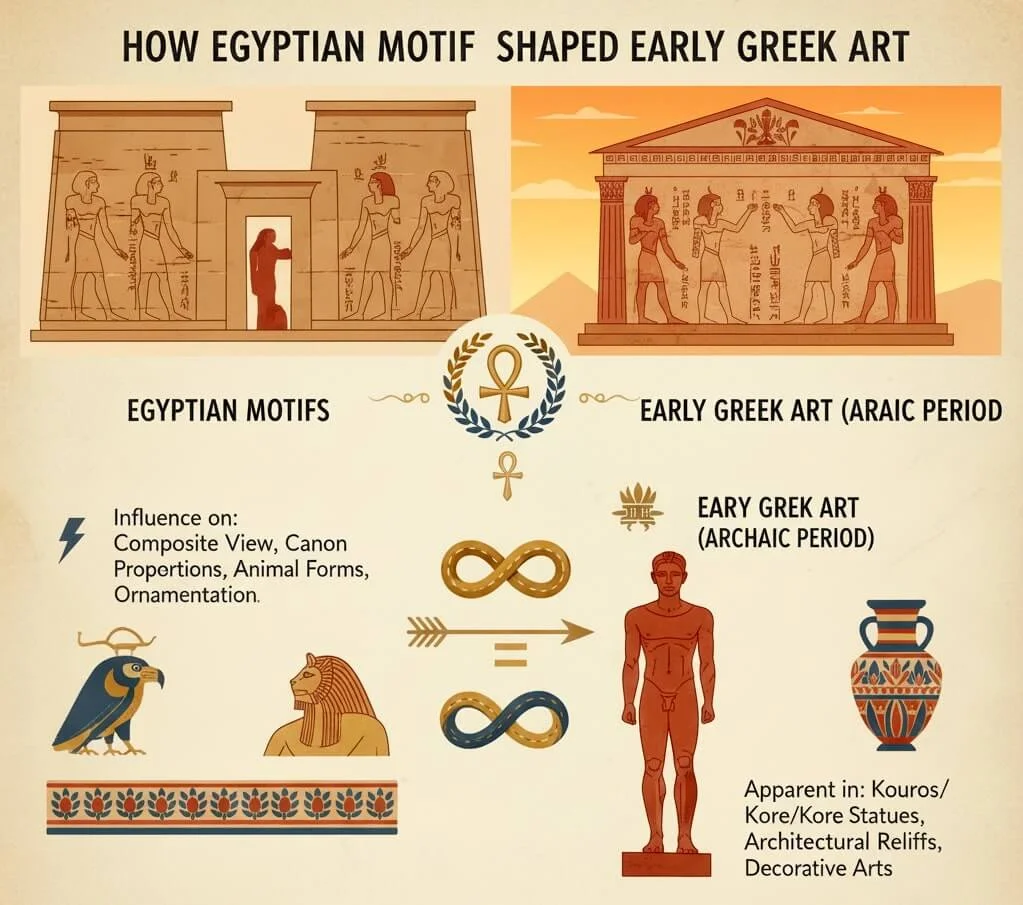
The early Greek sculptures known as kouros statues, often seen as the first step toward the naturalism of Classical Greek art, were heavily influenced by Egyptian techniques. Instead of developing their own monumental sculptural tradition from scratch, Greek artists adopted a proven system. They learned to use a proportional grid, similar to the one Egyptians used for centuries, to create their rigidly frontal, symmetrical figures. This direct borrowing of the Egyptian canon ensured consistency and a sense of divine order in their statues, which often featured a stiff, upright pose with one foot slightly forward.
This isn’t to say Greek artists simply copied Egyptian forms. They built upon this foundation. While the Egyptian statues often remained attached to a stone slab, the Greeks gradually began to “unlock” the figure from the block, carving away the negative space and creating a more freestanding sculpture. This crucial innovation was made possible by the underlying geometric principles learned from Egypt. The Egyptian influence on Greek sculpture provided the essential technical blueprint that allowed Greek artists to eventually evolve from the static, archaic forms to the dynamic and lifelike masterpieces of their golden age.
The Egyptian Iconography in Greek Art
The fusion of Egyptian and Greek cultures led to a fascinating convergence of artistic symbols and iconography. As Greeks encountered Egyptian art, they didn’t just admire its aesthetic; they adopted and adapted its powerful visual language. This created a shared vocabulary of symbols that transcended cultural boundaries, allowing for a deeper understanding of mythological and religious concepts.
A prime example of Egyptian influence on Greek civilization is the winged sun-disc. This potent symbol of divinity and royalty in Egypt was reinterpreted in Greek art. The Greeks used it to represent celestial power or a god’s presence.
Furthermore, Greek artists integrated the Uraeus, the upright cobra symbolizing divine authority and protection in Egyptian art. It often appears on sphinxes or as a decorative motif. The Greeks also adopted the sphinx. The sphinx, originally an Egyptian symbol of the pharaoh’s power, became a mythological creature in Greek art with its own narratives.
These artistic exchanges demonstrate how Egyptian iconography became a key source of inspiration for Greek artists, enriching their own art with ancient, powerful symbols that resonated with both civilizations’ understanding of the divine and the cosmic order.
How Ancient Temples Inspired Greek Architecture
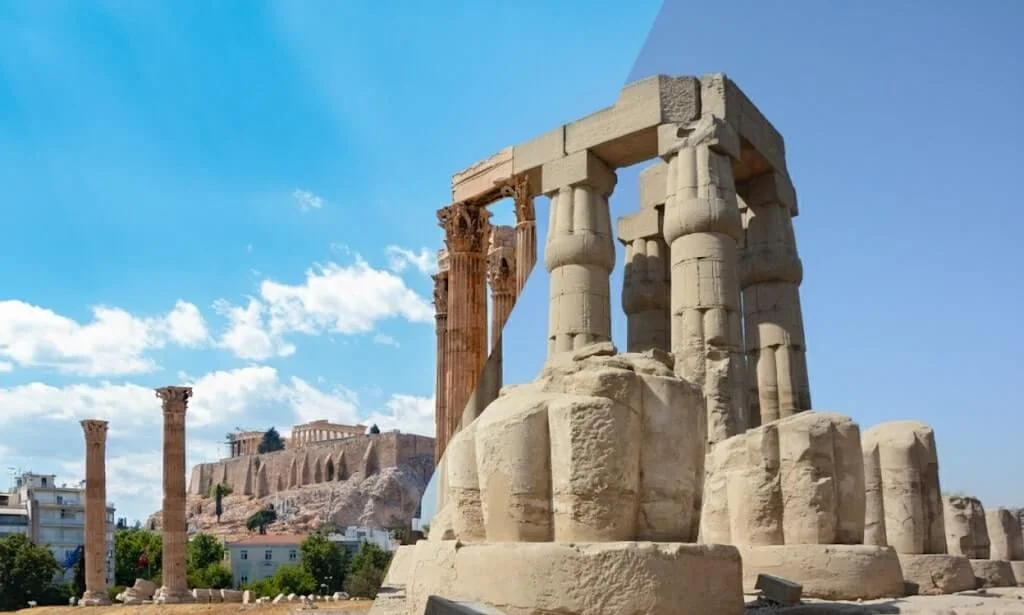
Beyond the Doric: Tracing Egyptian Influence on Greek Columnar Designs
While the Doric, Ionic, and Corinthian orders are iconic Greek creations, their foundational concepts came from Egypt. Greek architects didn’t invent the column out of thin air. Instead, they adapted Egyptian columnar designs, which had been in use for millennia. The Greeks learned the basics of creating a monumental, load-bearing column and then refined the form, ultimately developing their own distinctive styles.
The early Greek columns, particularly in the Doric style, show the clearest debt to Egypt. The fluting of Doric columns, for example, is thought to be an aesthetic evolution of the bundled reeds or palm stems seen in Egyptian columns. Egyptian architects had long used columns that resembled the papyrus plant or the lotus flower, and these forms were a direct inspiration. This Egyptian influence on Greek architecture was not a simple copy, but a crucial starting point that allowed the Greeks to develop their own unique and enduring architectural language.
The Egyptian Influence on Greek Temple Layouts & Alignment
The sacred geometry of ancient Egyptian temples profoundly influenced the layout and alignment of Greek temples. Greek architects didn’t just borrow design elements; they adopted fundamental principles of orientation and spatial organization. This ensured their temples were not only structurally sound but also imbued with a sense of divine harmony.
Aligning with the Cosmos
The Egyptians were masters of celestial alignment, orienting their temples to astronomical events like solstices or the rising of specific stars. They believed this connected the temple, and its resident deity, to the cosmos. Greek architects adopted this practice. For example, many Greek temples were aligned to face the rising sun on their deity’s festival day, a practice that directly mirrors Egyptian temple orientation. The Parthenon in Athens, for instance, aligns with the rising of the Pleiades. This Egyptian influence on Greek temples extended beyond aesthetics, establishing a spiritual connection between the building and the heavens.
Order and Symmetry in Temple Layouts
Egyptian temples were often laid out on a precise, symmetrical axis. A central processional path led visitors through a series of courtyards, halls, and finally to the innermost sanctuary. Greek temple layouts followed a similar linear, axial progression. The typical Greek temple had a central axis running from the entrance to the cult statue, creating a symmetrical and orderly experience. While the Greeks refined the use of the surrounding colonnade (peristyle), the underlying principle of a structured, symmetrical layout with a clear focal point was a direct borrowing from their Egyptian predecessors. This influence on Greek temple layouts made Greek temples not just places of worship, but carefully planned architectural expressions of order and balance.
Philosophical and Scientific Transmissions
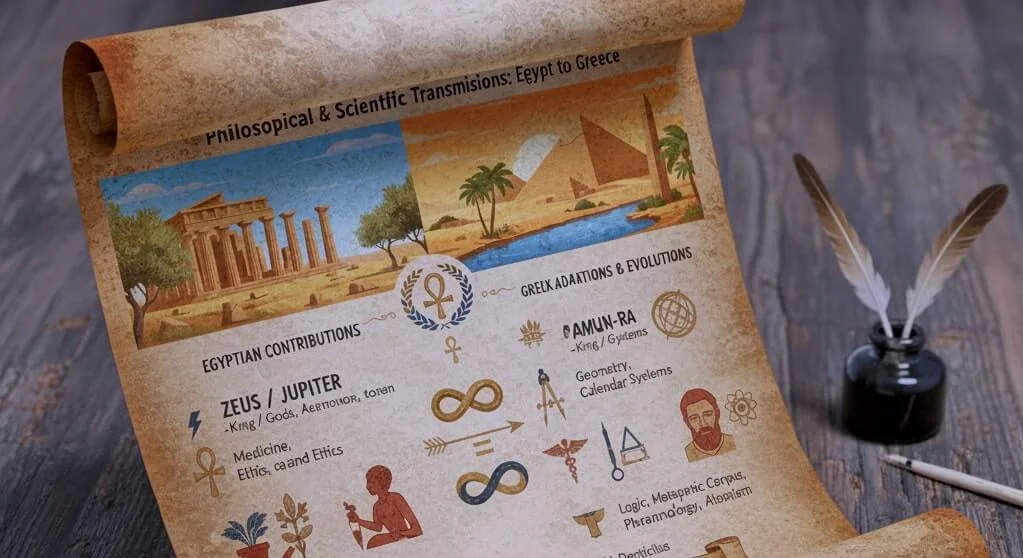
Math from the Nile: Greek Philosophy’s Debt to Egypt
The Egyptians provided the foundational knowledge of mathematics and geometry that Greek thinkers built upon. Greeks like Thales of Miletus learned practical geometry in Egypt, where it was used for tasks like land surveying after the Nile’s annual floods. This empirical knowledge gave the Greeks the data they needed to develop their abstract theories. While Egyptians focused on the practical application, the Greeks, most notably Pythagoras, took this knowledge and proved the universal principles behind it, transforming “how-to” into a theoretical “why.” This intellectual debt highlights how Greek philosophical and mathematical ideas were rooted in Egypt’s accumulated wisdom.
The Greek Gateway to Egypt: Naucratis
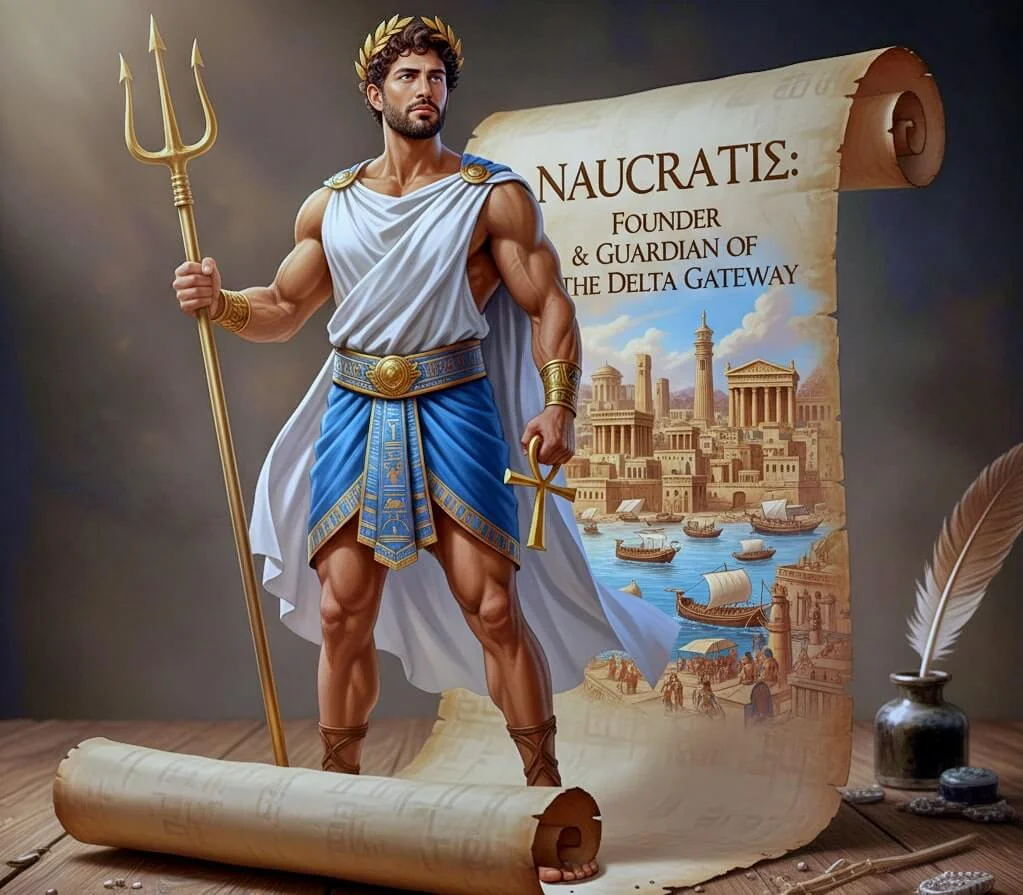
Naucratis: A Cultural Crossroads
Naucratis served as a vital cultural crossroads where Greek and Egyptian civilizations interacted directly and profoundly. As the only officially sanctioned Greek trading post in Egypt, it was more than just a marketplace; it was a permanent colony that facilitated a continuous flow of people, goods, and ideas. This unique role made it a melting pot where Greeks were exposed to Egyptian art, religion, and scientific knowledge firsthand, and Egyptians, in turn, encountered Greek culture.
The city’s existence as a designated hub allowed Greeks to establish temples, workshops, and permanent residences, rather than simply passing through. This close and prolonged interaction led to a significant cultural exchange. Greek artists and sculptors, for instance, studied Egyptian techniques, adopting the proportional grid system and frontal poses seen in kouros statues. Philosophers and scholars visited to learn from Egyptian priests and scribes, absorbing knowledge of mathematics, geometry, and astronomy. In return, Greek gods and pottery styles became popular among Egyptians living in the area. Naucratis, therefore, acted as a crucial bridge, making the Egyptian influence on Greek civilization tangible and direct.
African Symbolism on Greek Coinage
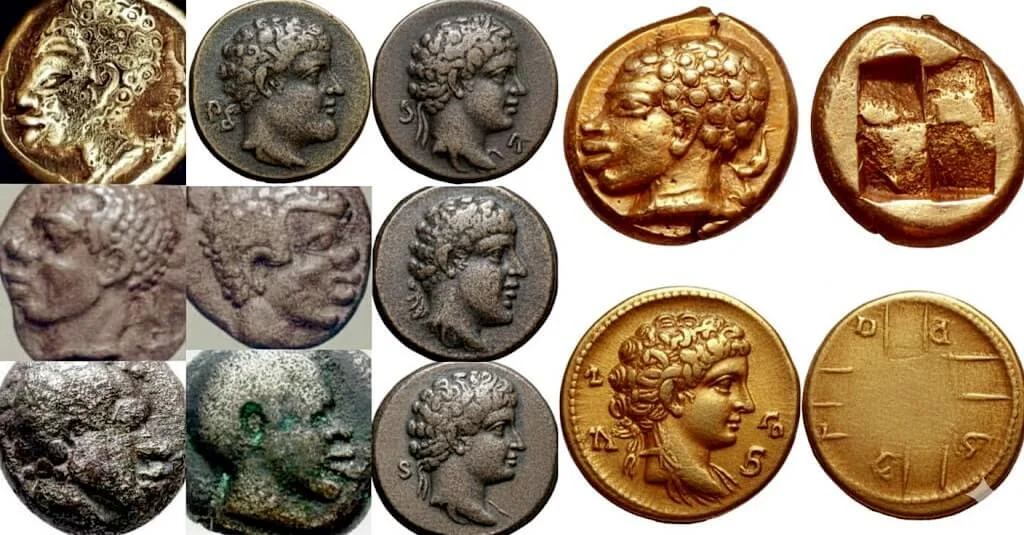
The Cultural Story of Coin Imagery
Greek coinage, particularly in cities with strong trade ties to Egypt, became a canvas for Egyptian influence. While Athenian coins featured native symbols like the owl, some Greek city-states and rulers, especially during the Hellenistic period, integrated Egyptian iconography into their coin imagery. This practice wasn’t merely decorative; it was a powerful statement of political alliance and cultural connection. Rulers, for instance, sometimes depicted themselves wearing the headdress of an Egyptian pharaoh or integrated symbols like the winged sun-disc, which was a potent symbol of divinity and royalty in Egypt. This blending of symbols on such a portable and widely used medium showed how deeply Egyptian motifs had penetrated Greek artistic and political thought. 🪙
This cultural exchange through coinage also extended to the depiction of deities. As the cult of the Egyptian goddess Isis gained popularity in the Greek world, her image began to appear on Greek and Hellenistic coins. This was a clear acknowledgment of her growing influence and the blending of religious beliefs. The presence of an African head on some Greek coins may represent African-derived cults or figures. For example, some associate the head with the god Dionysus, who was sometimes linked to Egypt. This numismatic evidence provides a tangible record of direct interaction and syncretism between these two great civilizations. It shows how coin imagery communicated economic value as well as a rich tapestry of shared spiritual and political identity.
Greek-Egyptian Economic and Political Ties
The relationship between Greece and Egypt was defined by a strong and mutually beneficial economic and political partnership that shaped the ancient Mediterranean. Economically, Greece was heavily dependent on Egypt for essential resources, primarily grain. As the “breadbasket of the ancient world,” Egypt’s fertile Nile Delta provided a reliable and abundant supply of food that was critical to sustaining the growing populations of Greek city-states, which often struggled with limited arable land. This trade was not one-sided; Greek merchants, particularly from cities like Athens and the Aegean islands, exported goods such as olive oil, wine, and high-quality pottery to Egypt. This vibrant trade network, centered at the Greek colony of Naucratis, fueled the economies of both regions and facilitated a constant flow of wealth and goods.
Politically, the relationship evolved from a mercantile partnership into one of strategic alliance. After the conquest of Egypt by Alexander the Great, the country was ruled by the Ptolemaic dynasty, a line of Greek-speaking pharaohs. This established a new era of direct political control and deepened the ties between the two regions. The Ptolemies promoted a syncretic culture, blending Greek administrative systems and philosophical thought with Egyptian traditions. They actively managed the grain trade to their advantage, ensuring a stable food supply for the Greek world while consolidating their power. This political structure created a powerful Hellenistic kingdom that was a dominant force in the Mediterranean for centuries, demonstrating a deep and enduring political bond.
The Egyptian Influence on Greek Culture
Egypt’s influence profoundly shaped Greek culture, affecting art, religion, science, and philosophy. This wasn’t a one-way transfer. It began with early trade and solidified with the Greek colony of Naucratis in the Nile Delta.
Greek artists and sculptors learned from their Egyptian counterparts. They adopted techniques like the proportional grid and the rigid frontal pose. We see this in their early kouros statues. Greek philosophers like Plato and Pythagoras traveled to Egypt to study. They absorbed knowledge of mathematics, astronomy, and religious concepts. This knowledge later informed their own work.
Additionally, Egyptian beliefs enriched Greek religion. The cult of Isis became popular, and her story had parallels with that of Demeter. This deep cultural exchange shows that Greek civilization, often considered the origin of Western thought, was built on a rich foundation of Egyptian knowledge and innovation.
Influence of Egypt on Greek Science and Medicine
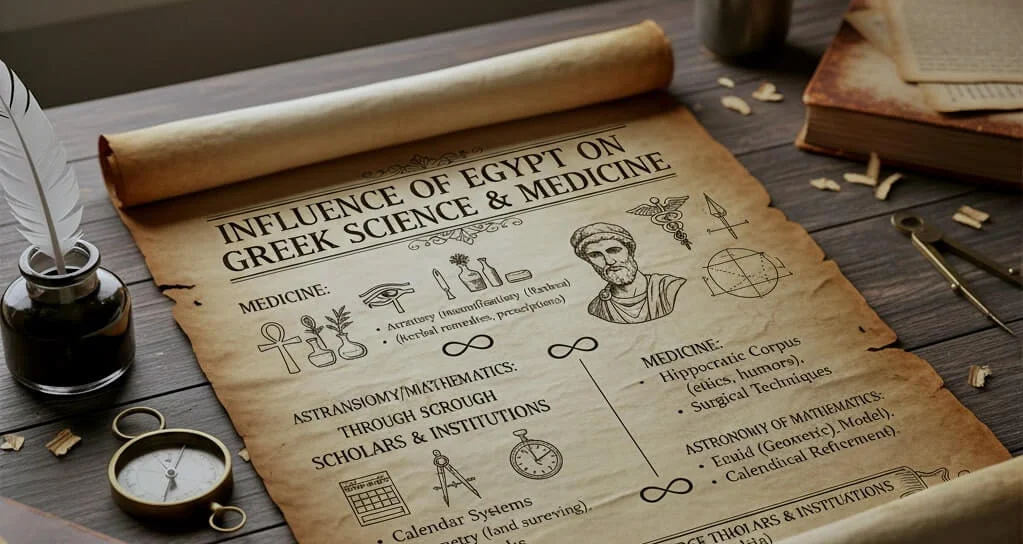
The Cosmos and Calendars
The Egyptian influence on Greek civilization is most evident in their inherited astronomical and calendrical knowledge. The Greeks built upon this foundational knowledge. Egyptian astronomy centered on practical observations of celestial bodies, a practice deeply intertwined with agriculture and religious rituals.
The most significant contribution was the 365-day civil calendar. It divided the year into 12 months of 30 days, plus five extra days. The calendar was based on the heliacal rising of the star Sirius, which coincided with the annual flooding of the Nile—a crucial event for Egyptian society.
The Egyptian calendar did not include a leap year. This caused it to slowly “wander” through the seasons. This 1,460-year cycle is known as the Sothic Cycle. Greeks and Romans later adopted and reformed the calendar into the Julian calendar. The Egyptian practice of dividing day and night into 12 hours laid the groundwork for the 24-hour day we use today.
Greek scholars in Alexandria absorbed this body of knowledge. This included sophisticated records and tools like the merkhet . This empirical foundation formed the basis for much of their own theoretical and mathematical approach to the cosmos.
The Egyptian Roots of Greek Medicine
Greek physicians were heavily influenced by advanced Egyptian medical practices. Greeks were impressed by texts like the Edwin Smith Papyrus, a surgical manual. It offered a rational approach to treating injuries, focusing on examination, diagnosis, and prognosis over magic. This rational method aligned with the Greeks’ own scientific traditions.
Greek doctors adopted specific Egyptian knowledge. This included a vast pharmacopeia from the Ebers Papyrus. They also learned practical surgical techniques for setting bones and suturing wounds. The Greeks greatly respected Egyptian medical knowledge. They equated the Egyptian physician-god Imhotep with their own healing god, Asclepius.
This transfer of knowledge culminated in Alexandria. There, Greek and Egyptian medical traditions merged. Greek physicians like Herophilus and Erasistratus built on this empirical foundation. They pushed the boundaries of anatomical science through human dissection.
The Political and Economic Impact of Greek and Egyptian Interaction
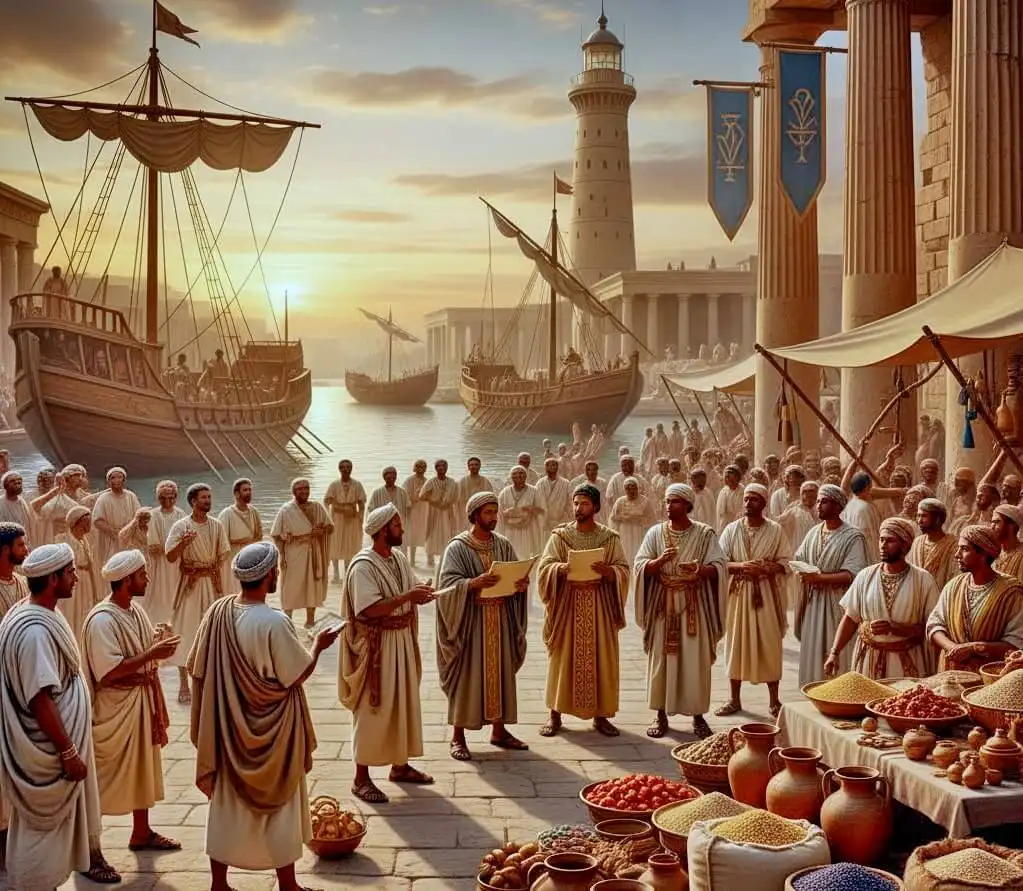
Alexandria: A Hub of Power and Culture
Alexander the Great founded Alexandria in 331 BCE. This city became the main bridge between Greek expansion and Egypt’s ancient legacy. Its strategic location on the Nile Delta made it the new capital of the Ptolemaic Kingdom. This new government center replaced traditional Egyptian power centers.
The Ptolemaic dynasty controlled Egypt’s rich resources. Its vast agricultural wealth became the economic engine of their empire. Alexandria’s harbor and location made it a major commercial hub. It connected trade routes across Europe, Asia, and Africa.
The Ptolemies also made Alexandria a leading center for Hellenistic culture. They established the world-renowned Library and Museum. This institution attracted scholars from all over the Hellenistic world. It became an intellectual nexus. Here, people studied and preserved Greek traditions. They also synthesized them with Egyptian and other Near Eastern knowledge.
Thus, Alexandria was more than just a city. It was a tangible representation of this cultural fusion. Political dominance was cemented by economic prosperity and cultural supremacy.
The Fusion of Cultures in Hellenistic Coinage
The Egyptian influence on Greek civilization is evident in the coinage of the Ptolemaic dynasty in Hellenistic Egypt. Coins became a powerful tool for the Ptolemies to legitimize their rule and showcase the fusion of Greek and Egyptian traditions. Before the Greeks, Egypt had no standardized monetary system; it relied on a barter economy and precious metal bullion. The Ptolemies introduced a sophisticated trimetallic system, mirroring Greek city-states, to finance their military and trade.
Early Ptolemaic coins featured distinct Greek iconography. They showed the bust of Ptolemy I or an eagle on a thunderbolt, a symbol of Zeus. Over time, the designs began to include Egyptian elements. Later Ptolemaic coins demonstrate this blending of cultures. The rulers wore Egyptian crowns, and the coins depicted syncretic gods like Zeus-Ammon, which combined the Greek king of gods with the principal Egyptian deity.
These coins circulated widely. They had a practical economic purpose, and they also visually communicated the dynasty’s effort to unify two distinct cultures under their rule.
Egyptian Lore’s Impact on Greek Literature
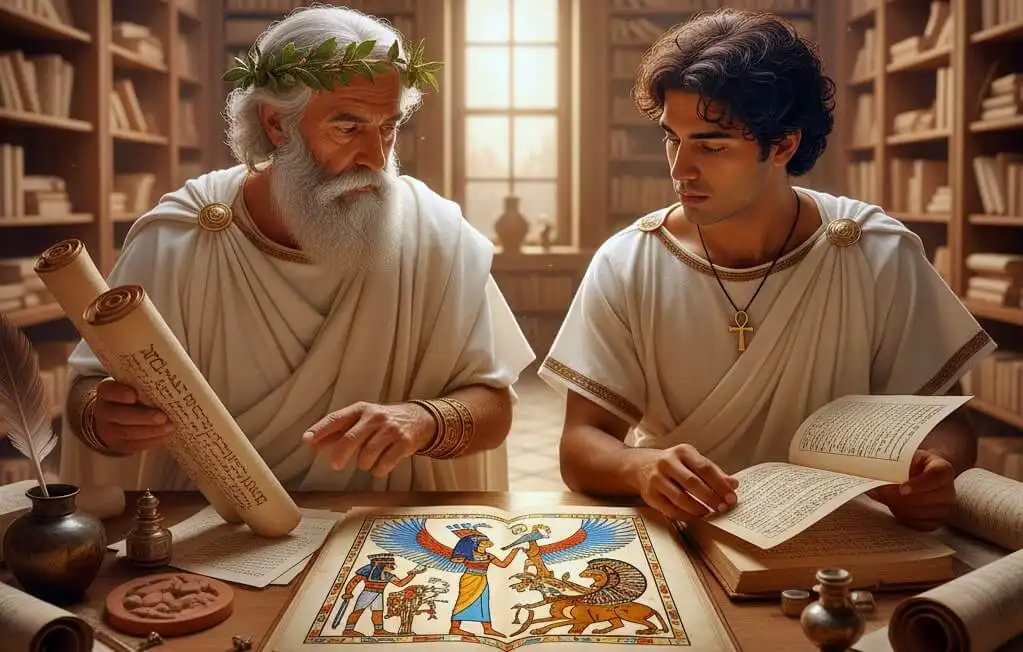
How Egyptian Stories Influenced Greek Writers
Ancient Egyptian literature, particularly its rich tradition of moral tales, myths, and wisdom texts, profoundly influenced Greek writers and philosophers. The Greeks, fascinated by Egypt’s antiquity and esoteric knowledge, absorbed Egyptian literary themes and narrative structures during the Hellenistic period. Egyptian wisdom texts provided practical advice on ethics and virtuous living. They bear a striking resemblance to later Greek philosophical dialogues and fables.
The “Tale of Sinuhe,” an Egyptian narrative, shares themes with Greek epic poems. Both stories feature a hero’s journey and a struggle with fate. Greek literature also adopted the Egyptian priest as a trope. They often portrayed them as a source of profound knowledge. For instance, in Plato’s dialogues Timaeus and Critias, Egyptian priests reveal the story of Atlantis.
This intellectual exchange enriched Greek literature. It added new philosophical dimensions and complex narrative forms. Greek writers built upon Egypt’s ancient literary heritage.
Ancient Egypt’s Lasting Gift to Greece and Western Culture
The Egyptian influence on Greek civilization was profound and multifaceted. Its wisdom flowed north, leaving an indelible mark on Greek society, from the spiritual to the intellectual.
Egyptian deities like Isis and Osiris joined the Greek pantheon. Their stories and rituals enriched Greek religious life and influenced beliefs about the afterlife. Greek artists and architects studied Egypt’s monumental works. They adopted new techniques and methods that redefined Greek sculpture and design.
This was more than just an artistic exchange; it was a sharing of knowledge. Greek minds like Pythagoras and Plato traveled to Egypt, absorbing ancient wisdom in geometry, astronomy, and medicine. This vibrant connection between two great civilizations created a foundation that would help shape the Western world for generations.

